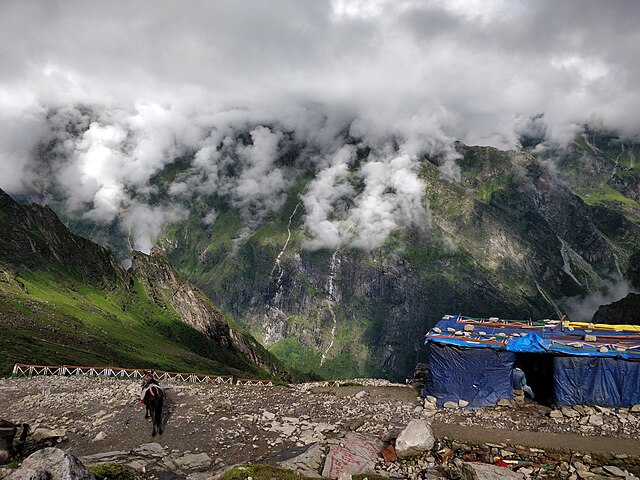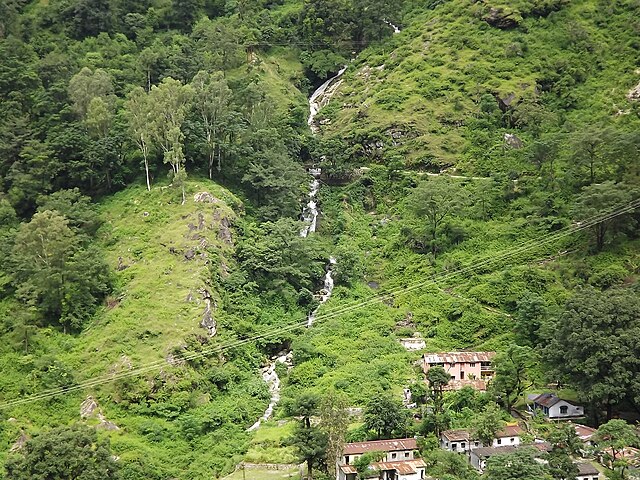Nestled at a breathtaking altitude of 4,329 meters (14,200 feet) in the Garhwal Himalayas, Hemkund Sahib experiences some of the most extreme temperature conditions you’ll encounter on any pilgrimage. Whether you’re planning your first visit to this sacred Sikh shrine or you’re a seasoned trekker, understanding the temperature patterns at Hemkund Sahib isn’t just helpful—it’s absolutely crucial for your safety and comfort.
Understanding Hemkund Sahib’s Unique Climate
The climate at Hemkund Sahib is what meteorologists call an “alpine tundra climate.” This means you’re dealing with conditions that can change dramatically within hours, sometimes even minutes. The sacred lake sits in a natural amphitheater surrounded by seven snow-capped peaks, creating a microclimate that’s both beautiful and unpredictable.
What Makes Hemkund Sahib’s Weather So Extreme?
Think of Hemkund Sahib as nature’s refrigerator at high altitude. The combination of elevation, surrounding glaciers, and geographical location creates a perfect storm for extreme temperature variations. The lake remains frozen for most of the year, typically from October to April, with ice thickness reaching several feet during peak winter months.
The surrounding peaks act like natural air conditioners, channeling cold winds across the lake surface. Even during the brief summer months, morning temperatures can drop below freezing while afternoon temperatures might reach a comfortable 15°C (59°F). It’s like experiencing winter and spring in the same day!
Monthly Temperature Breakdown at Hemkund Sahib

Understanding the monthly temperature patterns will help you plan your visit more effectively. Here’s what you can expect throughout the accessible months:
Summer Temperatures (May to September)
May (Opening Month):
- Morning: -5°C to 0°C (23°F to 32°F)
- Afternoon: 5°C to 10°C (41°F to 50°F)
- Night: -8°C to -3°C (18°F to 27°F)
June-July (Peak Season):
- Morning: 0°C to 5°C (32°F to 41°F)
- Afternoon: 8°C to 15°C (46°F to 59°F)
- Night: -5°C to 0°C (23°F to 32°F)
August-September (Monsoon Influence):
- Morning: -2°C to 3°C (28°F to 37°F)
- Afternoon: 5°C to 12°C (41°F to 54°F)
- Night: -7°C to -2°C (19°F to 28°F)
Winter Conditions: Why Hemkund Sahib Remains Closed
From October to April, Hemkund Sahib transforms into a frozen wonderland that’s completely inaccessible to pilgrims. Winter temperatures plummet to extreme lows:
- Average temperature: -15°C to -25°C (5°F to -13°F)
- Extreme lows: Can drop to -35°C (-31°F)
- Snow depth: 10-15 feet in many areas
- Lake condition: Completely frozen with ice thickness of 3-4 feet
The trek route becomes treacherous with avalanche risks, making it impossible for safe passage. This is why the shrine remains officially closed during these months.
Daily Temperature Variations You Should Expect
One of the most challenging aspects of Hemkund Sahib’s climate is the dramatic temperature swing within a single day. You might start your morning trek in sub-zero conditions, enjoy pleasant afternoon temperatures, and then face freezing conditions again by evening.
This temperature roller coaster happens because of the thin atmosphere at high altitude. During the day, the sun’s rays can warm the air quickly, but once the sun sets or gets blocked by clouds, temperatures drop rapidly. It’s not uncommon to experience a 20°C (36°F) temperature difference between day and night!
Factors Affecting Hemkund Sahib Temperature
Altitude Impact on Temperature
The primary factor determining Hemkund Sahib’s frigid conditions is its extreme altitude. For every 1,000 meters you climb, the temperature drops by approximately 6.5°C (11.7°F). Starting from Govindghat at 1,828 meters, by the time you reach Hemkund Sahib at 4,329 meters, you’ve climbed over 2,500 meters—that’s a potential temperature drop of 16°C (29°F) due to altitude alone!
Weather Patterns and Seasonal Changes
The weather at Hemkund Sahib follows distinct patterns influenced by both the Indian monsoon and western disturbances from the Mediterranean. These weather systems create a complex interplay that affects temperature stability throughout the pilgrimage season.
Monsoon Effects on Temperature and Accessibility
During monsoon months (July-August), while temperatures might be slightly warmer during the day, the increased cloud cover and precipitation can make conditions feel much colder. Rain at lower altitudes often means snow at Hemkund Sahib, even in summer months.
Best Time to Visit Based on Temperature

Ideal Weather Windows for Pilgrimage
If you’re looking for the most favorable temperature conditions, plan your visit during these periods:
Prime Time: Mid-June to Mid-July This is when you’ll find the most stable and relatively warm weather. Morning temperatures are less likely to drop below freezing, and afternoon conditions can be quite pleasant for trekking.
Good Alternative: Early September Post-monsoon period offers clear skies and crisp air, though temperatures can be more variable. The advantage is fewer crowds and crystal-clear mountain views.
Temperature Considerations for Different Visitor Types
First-time Visitors: Stick to June-July when temperatures are most predictable and less extreme.
Experienced Trekkers: May and September offer unique experiences with more challenging temperature conditions but spectacular scenery.
Elderly Pilgrims: Mid-June to mid-July provides the safest temperature range for comfortable pilgrimage.
Photographers: Early September offers the clearest skies, though you’ll need to handle more extreme temperature variations.
Essential Packing Guide for Hemkund Sahib’s Climate
Clothing Recommendations for Temperature Variations
Layering is your best strategy for dealing with Hemkund Sahib’s temperature extremes. Think of your clothing system as your personal climate control:
Base Layer: Merino wool or synthetic thermal underwear that wicks moisture and retains warmth even when wet.
Insulation Layer: Down or synthetic insulated jacket that you can easily put on or remove as temperatures change.
Outer Shell: Waterproof and windproof jacket to protect against rain, snow, and harsh winds.
Lower Body: Insulated trekking pants with waterproof outer layer for harsh conditions.
Extremities: Insulated gloves, warm hat, and quality trekking socks are non-negotiable items.
Emergency Weather Gear You Must Carry
- Emergency bivvy sack for unexpected weather changes
- Extra dry clothing in waterproof bag
- Hand and foot warmers for extreme cold
- Emergency shelter or tarp
- Thermal blanket (space blanket)
Safety Precautions for Extreme Temperature Conditions
Recognizing Weather-Related Health Risks
The extreme temperatures at Hemkund Sahib can pose several health risks that every pilgrim should understand:
Hypothermia: When your body temperature drops below 95°F (35°C). Early signs include uncontrollable shivering, confusion, and loss of coordination.
Frostbite: Freezing of skin and underlying tissues, most commonly affecting fingers, toes, nose, and ears.
Altitude Sickness: While primarily altitude-related, cold temperatures can worsen symptoms and slow acclimatization.
Dehydration: Cold weather reduces your sense of thirst, but you still lose fluids through breathing and sweating under layers.
Early recognition and proper response to these conditions can be life-saving. Always trek with companions and inform them about these risks before starting your journey.
Temperature Monitoring and Weather Updates

Real-Time Weather Resources for Hemkund Sahib
Staying informed about current temperature conditions is crucial for safe travel. Here are reliable sources for weather updates:
Local Weather Stations: Joshimath and Badrinath weather stations provide the most relevant regional forecasts.
Trekking Agencies: Local operators often have real-time communication with guides and can provide current conditions.
Government Sources: Indian Meteorological Department (IMD) provides official weather forecasts for the region.
Mobile Apps: Weather apps with high-altitude forecasting capabilities can be helpful, though always verify with local sources.
Remember that weather conditions can change rapidly at high altitude, so even the most recent forecasts should be taken as general guidance rather than absolute predictions.
Conclusion
Understanding Hemkund Sahib’s temperature patterns is your key to a safe and comfortable pilgrimage experience. The extreme conditions at this sacred site demand respect, preparation, and flexibility. While the challenging climate might seem daunting, proper planning and the right gear will help you focus on the spiritual significance of your journey rather than fighting the elements.
Remember that every year brings slight variations in weather patterns, and climate change is gradually affecting high-altitude regions. Stay flexible with your plans, prioritize safety over schedule, and always be prepared for temperature conditions that are more extreme than forecasted.
The reward for braving these challenging conditions is an experience that will stay with you forever—standing beside the pristine glacial lake where Guru Gobind Singh is believed to have meditated, surrounded by some of the most spectacular mountain scenery in the world.
Frequently Asked Questions
1. What is the coldest temperature ever recorded at Hemkund Sahib?
While official records are limited due to the remote location, local guides report temperatures dropping as low as -35°C (-31°F) during winter months. Even during the pilgrimage season, temperatures can drop to -10°C (14°F) or lower during particularly cold nights.
2. Can I visit Hemkund Sahib if I’m sensitive to cold weather?
Yes, but you’ll need extra preparation. Visit during the warmest period (mid-June to mid-July), invest in high-quality insulated clothing, and consider shorter stays at the lake. Consult your doctor if you have circulation issues or other cold-sensitivity conditions.
3. How quickly do temperatures change at Hemkund Sahib during the day?
Temperature changes can be extremely rapid, sometimes dropping or rising 10-15°C (18-27°F) within an hour when weather systems move through. This is why layered clothing and quick-access gear are essential.
4. Is it safe to camp overnight at Hemkund Sahib given the temperature conditions?
Camping is not officially permitted at Hemkund Sahib, and the extreme temperature drops at night make it potentially dangerous without proper high-altitude camping gear. Most pilgrims stay overnight in Ghangaria and make day trips to the lake.
5. How do local weather patterns affect the pilgrimage season dates each year?
The official opening and closing dates of Hemkund Sahib can vary by 2-3 weeks depending on snowfall, temperature patterns, and accessibility of the trek route. Heavy snowfall or extended cold periods can delay opening, while early winter conditions can force early closure. Always check current year announcements before planning your trip.

